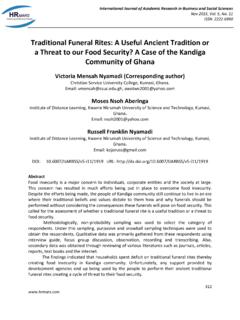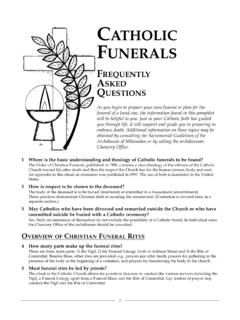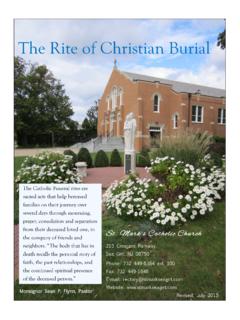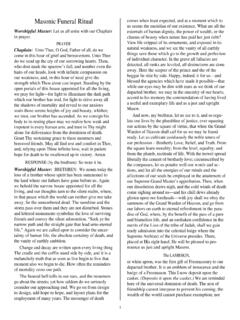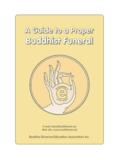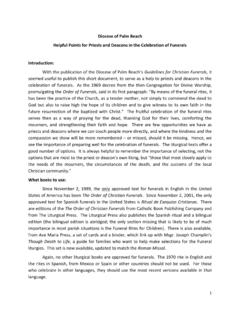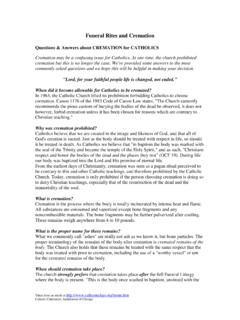Transcription of Catholic Funeral Rites - Cabrini
1 St. Frances Cabrini (2011) Catholic Funeral Rites The Catholic Funeral Rites consist of three components: I. The Vigil for the Deceased Usually the evening before the burial Usually at the Funeral home, but can be done in the narthex of church if the church is available The normative format is the readings and prayers that make up the official Vigil for the Deceased, but other options are possible: Liturgy of the Word Evening Prayer from the Liturgy of the Hours (Office of the Dead) Rosary The Vigil is the best time for a eulogy or shared remembrances II. The Mass of Christian Burial Celebrated at the parish church, unless special permission is granted by the priest to hold it at a Funeral chapel This is the central celebration of the Christian Funeral Due to the nature of the liturgy, eulogies are discouraged at the Mass itself.
2 They are much better done at the Vigil for the Deceased the evening before or at the Funeral luncheon. In some circumstances a eulogy at the Funeral Mass may be permitted, but there must be only one, and it must be less than 5 minutes. See more detailed guidelines below. III. The Rite of Committal These final prayers before burial are normally prayed at the graveside, as we commit our loved one to the hands of God. On the following pages you ll find help with the following: Planning for the Funeral Rite Printed Programs Scripture Readings Music for the Funeral Mass Eulogies Suggestions for describing the Funeral Rites in the newspapers St. Frances Cabrini (2011) Planning for the Funeral Rite When you meet with the parish priest of liturgy director, you will receive a copy of the book Through Death to Life by Fr.
3 Joseph Champlin (Ave Maria Press). For advance planning, you can also get a copy of this book at the parish office. It contains all the suggested options for Scripture reading and prayers, as well as a handy tear-out planning sheet for you to submit to the priest of liturgy director. The first thing the priest or deacon will need to know is whether the body will be present or if there are cremated remains. It is preferred that the body be present for the Funeral Mass and if cremation is to take place that it be done following the Mass. Here are some of the choices you ll need to communicate to the parish: a. Scripture readings (more information below) b. Music choices (more information below) c. Is there a visiting priest? d. Will anyone be eulogizing following communion?
4 E. Do you want a Funeral luncheon? How many will be coming? f. Routinely provided by a group of parish volunteers (donation) and Usually held in the School Gym or Squire Hall immediately following the burial at the cemetery. Printed programs If you are having someone prepare a printed program for the Mass you we will need the following information. Exact dates of birth and death If you wish, a favorite photo to be used on the front cover of the program The names of the following: a. Readers of first and second reading b. Readers of General Intercessions (Prayers of the Faithful) (if desired, the priest or cantor can read these) c. Pall bearers d. Gift bearers (to present the bread and wine at offertory) e. Alter servers (if applicable; normally these are provided by the parish) f.
5 Extraordinary Minister of Holy Communion (EMHC), if communion under both species is desired. These must be officially commissioned EMHCs and at least one must be a member of the parish. Upon request, the parish will recruit EMHCs for you. St. Frances Cabrini (2011) Scripture Readings The Catholic Church offers a wide selection of Scripture readings for the Funeral Rites . You will likely find excellent readings from among this list, but you may choose another Scripture reading if another passage is particularly appropriate for you or your loved one. You will need to choose 4 Scripture readings for the Mass (see the book Through Death to Life): First Reading from the Old Testament (or from Acts or Revelation in Easter Season Responsorial Psalm from the Book of Psalms Second Reading from the New Testament Epistles Gospel Reading The first and second reading may be proclaimed by a family member or friend, or you may ask a parish lector to read them.)
6 The readers should have a good grasp of the principles of proclaiming the Word of God in public. Be sure to give them a copy of the reading in advance, and encourage them to practice the reading at the ambo (lectern) in church to get the feel of the acoustics and microphone. The responsorial psalm should preferably be sung by the cantor, but it can be recited if necessary. All the passages listed below may be found in the New American Bible which is used in our liturgies. First Reading from the Old Testament (Pages 37-46 of Through Death to Life. *Denotes most often-used readings.) 2 Maccabees 12:43-46 Job 19:1, 23-27a *Wisdoms 4:7-15 *Isaiah 25:6a, 7-9 *Lamentations 3:17-26 Daniel 12:1-3 During the Easter Season (Easter to Pentecost) one of the following is used instead of a passage from the Old Testament Acts 10:34-43 (or shorter version Acts 10:34-36,42-43) *Revelation 14:13 Revelation 20:11-21:1 *Revelation 21:1-5a, 6b-7 Responsorial Psalm (usually sung by the cantor) (Pages 47-56 of Through Death to Life.)
7 *Denotes most often used readings.) *Psalm 23:1-3, 4,5,6 *Psalm 25:6 and 7b, 17-18, 20-21 *Psalm 27:1,4,7, and 8b and 9a, 13-14 Psalm 42:2,3,5cdef; 43:3,4,5 *Psalm 63:2, 3-4, 5-6, 8-9 *Psalm 103:8 and 10, 13-14,15-16, 17-18 *Psalm 116:5, 6,10-11,15-16ac Psalm 122:1-2, 4-05, 6-7, 8-9 *Psalm 130: 1-2, 3-4, 5-6ab, 6c-7, 8 Psalm 143: 1-2, 5-6, 7ab and 8ab, 10 St. Frances Cabrini (2011) Second Reading from the New Testament Epistles (Pages 58-67 of Through Death to Life. *Denotes most often used readings.) Romans 5:5-11 Romans 5:17-21 Romans 6:3-9 (or shorter version Rom 6:3-4,8-9) Romans 8:14-23 *Romans 8:31b-35, 37-39 Romans 14:7-9, 10c-12 *1 Corinthians 15:20-28 (or shorter version 1 Cor 15:20-23) 1 Corinthians 15:51-57 *2 Corinthians 4:14 5:1 2 Corinthians 5:1, 6-10 Philippians 3:20-21 1 Thessalonians 4:13-18 2 Timothy 2:8-13 *1 John 3:1-2 1 John 3:14-16 Gospel Reading (read by the priest or deacon only) (Pages 70-88 of Through Death to Life.
8 *Denotes most often used readings.) Tell us your preferred choice but homilist may want to choose his own. *Matthew 5:1-1a *Matthew 11:25-30 Matthew 25:1-13 Matthew 25:31-46 Mark 15:33-39; 16:1-6 (or shorter version Mk 15:33-39) Luke 7:11-17 Luke 12:35-40 Luke 23:33, 39-43 Luke 23:44-46, 50,52-53; 24:1-6a (or shorter version Lk 23:44-46,50,52-53) Luke 24:13-35 (or shorter version-Lk 24:13-16, 28-35) John 5: 24-29 *John 6:37-40 *John 6:51-59 *John 11:17-27 (or shorter version: John 11:21-27) John 11:32-35 *John 12:23-28 (or shorter version: John 12:23-26) *John 14:1-6 John 17:24_26 John 19:17-18, 25-39 Music for the Funeral Mass The music for the Funeral liturgy, as the music at all Catholic liturgy, should encourage the participation of all those present in sung prayer.
9 Our Pastoral Associate for music can help you with this. Music selections include: Prelude music Processional Psalm Preparation of gifts Communion Recessional Remuneration for the musicians time and expertise is expected. This needs to be arranged with musician(s) prior to the Funeral . St. Frances Cabrini (2011) Eulogies A eulogy, or tribute to the deceased, has in the past often been inserted into the Funeral Mass, but current liturgical guidelines strongly discourage this practice. The Order of Christian Funerals (the Catholic Church document governing Catholic funerals) is quite clear that a brief homily should be given at the Funeral liturgy, but never is any kind of eulogy to replace the homily (OCF #141). This does not mean that the deceased cannot be spoken about in the homily, but that the Word of God must be primary.
10 The homilist (priest or deacon) speaks the scriptural word that helps the assembly understand that the mystery of the death and resurrection of Jesus is operative in the life and death of the deceased. In certain cases, a remembrance by a family member or friend during the Funeral Mass may be allowed, either at the beginning of Mass or after communion. This must be arranged with the priest a day or two ahead of time, not minutes before Mass. If permission is granted for a remembrance or eulogy to be given a Mass, the following guidelines MUST be observed: Only one person may speak (unless translation to another language is needed for the benefit of the assembly) The remembrance must be brief: no more than 5 minutes The remembrance should be well prepared in advance so that it is focused and stays within the 5-minute time limit.

